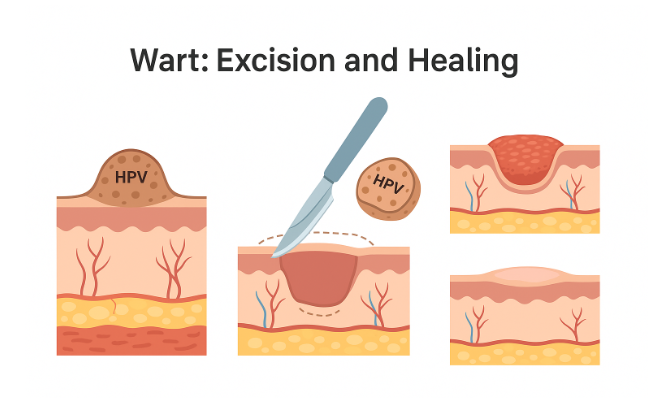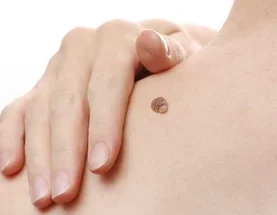Overview
A wart (also known medically as verruca) is a small, usually benign growth on the skin or mucous membrane caused by an overgrowth of cells in the upper layer of the skin. While most warts are non-cancerous and self-limiting, some may persist, spread, or resemble more serious conditions such as skin cancers — hence, accurate diagnosis and careful management are essential.
At MACS Clinic, we offer comprehensive diagnostic evaluation and both surgical and non-surgical treatment options for warts, prioritising safety, efficacy, and histopathological confirmation where appropriate.
Causes of Warts
- Infective Origin:
Most warts are caused by infection with the human papillomavirus (HPV). There are over 100 types of HPV, and each type tends to cause warts in specific areas (hands, feet, face, genital region, etc.).
Transmission can occur through:- Direct skin-to-skin contact
- Contact with contaminated surfaces (e.g. gym floors, communal showers)
- Autoinoculation (spreading the virus from one area to another by scratching or shaving)
- Direct skin-to-skin contact
Benign Tumour Origin:
Occasionally, growths that resemble warts are benign tumours of skin appendages such
- as seborrhoeic keratosis or fibroepithelial polyps (“skin tags”).
- Malignant or Pre-malignant Lesions:
Rarely, lesions resembling warts may actually represent squamous cell carcinoma, Bowen’s disease, or keratoacanthoma.
→ For this reason, excision and histopathological analysis are strongly advised when the diagnosis is uncertain, the lesion is atypical, or when it occurs in elderly or immunosuppressed patients.
Immunosuppression:
Individuals with weakened immune systems — due to HIV infection, organ transplantation, chemotherapy, or systemic illnesses — are more prone to develop multiple, persistent, or unusually large warts.
This reflects the immune system’s reduced ability to control HPV infection.
Type | Typical Location | Description |
Common warts (Verruca vulgaris) | Hands, fingers, knees | Rough, raised surface; often cauliflower-like |
Plantar warts (Verruca plantaris) | Soles of feet | Flat or depressed lesions, often painful on pressure |
Plane or flat warts (Verruca plana) | Face, back of hands | Smooth, flat-topped lesions; often multiple |
Filiform or digitate warts | Face, eyelids, lips | Thread-like, finger-like projections |
Genital warts (Condyloma acuminata) | Genital and anal regions | Moist, cauliflower-like growths; sexually transmitted |
Subungual / periungual warts | Around fingernails and toenails | Can distort the nail plate |
Diagnosis
- Clinical examination by a trained clinician is often sufficient.
- Dermatoscopic evaluation may help differentiate benign from malignant lesions.
- Histopathological examination (biopsy or excision specimen) is the gold standard to confirm diagnosis, rule out malignancy, and identify the exact wart subtype.
Treatment Options
1. Non-Surgical / Destructive Treatments
- Cryotherapy (liquid nitrogen freezing)
→ Freezes wart tissue, causing it to slough off.
Advantages: Quick, minimal downtime.
Disadvantages: Painful; may require multiple sessions; no tissue for histopathology. - Chemical Cauterisation
→ Application of salicylic acid or trichloroacetic acid to destroy infected tissue.
Advantages: Simple and inexpensive.
Disadvantages: Needs regular application; risk of skin irritation; no diagnostic sample. - Electrocoagulation / Radiofrequency Ablation / Laser Therapy
→ Energy-based destruction of wart tissue.
Advantages: Rapid clearance.
Disadvantages: No tissue available for histology; small risk of scarring and recurrence.
⚠️ Note:
While destructive methods can remove the visible lesion, they do not provide tissue for histopathological examination, which is vital when the diagnosis is uncertain or malignancy is suspected.
2. Surgical Excision (Preferred at MACS Clinic)
At MACS Clinic, we frequently recommend minor surgical excision under local anaesthesia for diagnostic and therapeutic purposes.
- Advantages:
- Enables definitive removal of the lesion.
- Provides tissue for histopathological analysis to confirm the diagnosis.
- Reduced recurrence if entire lesion excised.
- Simple, well-tolerated day-case procedure.
- Enables definitive removal of the lesion.
- Disadvantages:
- Minor scar formation possible.
- Slightly longer healing time compared to destructive methods.
- Minor scar formation possible.
Rare risk of infection, bleeding, or delayed wound healing.
Recurrence and Follow-up
- Warts can recur if small viral remnants remain in the tissue or if the immune system remains susceptible.
- Surgical removal reduces this risk compared to superficial treatments.
- Maintaining good skin hygiene, avoiding sharing personal items, and treating any underlying immunosuppression can minimise recurrence.
Post-Operative Care (After Excision)
- Keep the area clean and dry for the first 24 hours.
- After that, gentle cleaning with mild antiseptic solution once daily.
- Topical antibiotic ointment and a small dressing for 3–5 days.
- Avoid soaking, friction, or trauma to the area until healing is complete (usually 7–10 days).
Attend scheduled follow-up to review wound healing and histopathology results.
Possible Complications
- Minor bleeding or oozing
- Infection (rare; managed with antibiotics if required)
- Local scarring or pigmentation changes
- Recurrence, particularly in viral warts
- Discomfort for a few days after treatment
Why Choose MACS Clinic, Watford
- All procedures performed by qualified plastic surgeons under aseptic conditions.
- Facility for histopathological confirmation to ensure accurate diagnosis.
- Comprehensive aftercare and follow-up.
- Evidence-based management tailored to individual needs and skin type

Summary Table
Treatment Type | Histopathology Possible | Recurrence Risk | Scarring Risk | Pain/Recovery |
Chemical / Cryotherapy | No | Moderate | Low | Minimal |
Laser / Coagulation | No | Moderate | Low-Moderate | Minimal |
Surgical Excision | Yes |
Conclusion
While most warts are harmless, proper diagnosis is crucial — particularly in adults and immunocompromised patients.
At MACS Clinic, we prioritise surgical excision with histopathological confirmation to ensure that every lesion is accurately identified and safely treated.
This approach combines medical safety with aesthetic precision for optimal outcomes.
Contact MACS Clinic
- Phone: 020 7078 4378
- WhatsApp: 07792 648 726
- Email: enquiries@macsclinic.co.uk
- Website: www.macsclinic.co.uk
BOOK a FREE Video Consultation: https://calendly.com/macsclinic/free-video-consultation?month=2025-01







